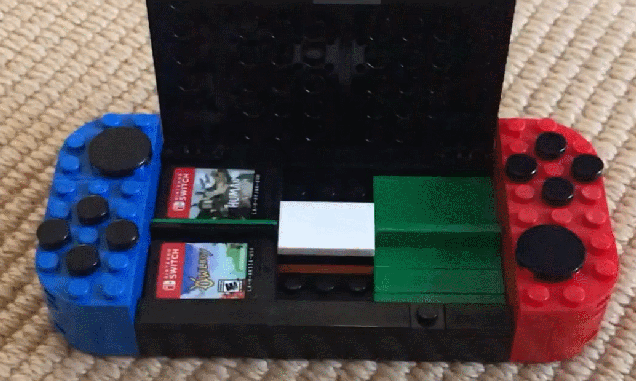https://kotaku.com/lego-are-the-perfect-size-for-building-a-switch-game-ca-1833268346

Someone made a fun Lego replica of a Nintendo Switch that doubles as a nifty little case for Switch games.
via Kotaku https://kotaku.com
March 13, 2019 at 01:11PM

For everything from family to computers…
https://kotaku.com/lego-are-the-perfect-size-for-building-a-switch-game-ca-1833268346

Someone made a fun Lego replica of a Nintendo Switch that doubles as a nifty little case for Switch games.
via Kotaku https://kotaku.com
March 13, 2019 at 01:11PM
https://www.wired.com/story/gallery-objects-cut-in-half

Growing up in Vancouver, Mike Warren liked to take apart electronics for fun—VCRs, phones, anything he could get his hands on. He’s still taking stuff apart, but instead of a screwdriver he now uses a state-of-the-art, 60,000-psi water jet cutter capable of slicing through 3 inches of steel. Such water jets, which use a mixture of water and extra-fine garnet sand, are generally used to cut sheet metal, but a few years ago Warren began using one to bisect ordinary objects like boxing gloves, oil filters, and golf balls that he found at Goodwill or other second-hand stores.
“Basically, it’s whatever I find that I think would look interesting cut in half,” he says.
After studying engineering and architecture in college, Warren worked for four years as a city planner in Burnaby, British Columbia, but found the pace of urban design too slow for his restless curiosity. In his free time, he created YouTube videos of his homemade inventions, eventually leading to a new job at the San Francisco-based company Instructables, which produces open-source DIY hardware projects. In 2011, Instructables was acquired by the software company Autodesk, which, in addition to its main business, maintains the design workshop where Warren now works.
Warren’s YouTube videos showing him cutting open power drills and soccer cleats proved so popular that he ended up creating a dedicated channel just for them. To date, he has sliced up more than 80 objects, several dozen of which are included in a deluxe book published last year by Chronicle, featuring photographs by Jonothan Woodward and annotations by Warren. Although he’s cut open iPhones, DSLR cameras, and laptops, one of Warren’s favorite object autopsies was the humble clothing iron.
“We all sort of know how an iron works, but when you take it open you can actually see how the water goes through and the metal plate gets heated,” he says. “With today’s tech, it’s space-optimized everything, but if you open up something older like a rotary phone, there’s so much space inside. They were designed for form rather than function.”
Not everything Warren has tried to cut open has been a success. If there are too many layers of materials, the water jet gets deflected and ends up making a ragged cut, as with a bicycle tire Warren tried to bisect. But often the most ordinary-looking items also make the most intriguing ones after their cross-section has been revealed. “Sometimes things I don’t think will look interesting, when I cut them open I’m really surprised,” he says. “That’s the appeal for me, and that’s what I want to share with people.”
via Wired Top Stories https://ift.tt/2uc60ci
March 13, 2019 at 09:06AM
https://geekologie.com/2019/03/okay-driving-a-car-with-saw-blades-for-w.php

This is a video from the folks of the Beyond The Press Youtube channel of a Subaru that’s had its tires replaced with giant saw blades being taken out for a spin on a frozen lake. It actually performs surprisingly well once the driver gets the hang of its handling. Now they should replace the car’s steering wheel with a saw blade for some BONUS fun. "Fun?" I meant danger and bleeding.
Keep going for the video, actual driving starts around 3:00, some real driving around 4:45, and the trip home tearing up some snow-covered roads at 10:20.
Thanks to Marc B, who agrees plus you can rent out the car in the summer to cut lumber for construction jobs.
via Geekologie – Gadgets, Gizmos, and Awesome https://geekologie.com/
March 12, 2019 at 11:21AM
https://www.engadget.com/2019/03/12/google-releases-offline-gboard-speech-recognizer-for-pixel/
You can now dictate your texts with Google’s Gboard keyboard even when you’re offline, at least if you use a Pixel. Google’s AI team announced that it updated the Gboard’s speech recognizer to recognize characters one-by-one as they’re spoken, and it is now hosted directly on the device. By no longer having to send data over the internet, Gboard’s voice typing should now be faster and more reliable. Google explained in a blog post that it wanted to create a speech recognizer that was "compact enough to reside on a phone" and wouldn’t be derailed by unreliable WiFi or mobile networks.
Voice recognition traditionally works by breaking apart the words you speak into smaller parts known as phonemes, according to Science Line. The speech recognizer would then analyze the order, pattern, and context of the phonemes in order to generate a sentence. This would usually result in a lag as you waited for the software to make its best guess at what you were actually saying. Google’s AI team stated in the post that its model "outputs characters one-by-one, as you speak, with white spaces where appropriate." In other words, Gboard will recognize individual letters of the words you say as you say them, rather than recognizing phonemes.
At present, the Gboard update is only available in American English and on Pixel phones. Google’s AI team may expand the update to include more languages and more devices in the future.
Source: Google
via Engadget http://www.engadget.com
March 12, 2019 at 09:24PM
https://www.engadget.com/2019/03/13/google-lookout-app-us-release/
Google’s Lookout is now finally available for download, though it’s only compatible with Pixel devices in the US set to English at the moment. The application was first announced at Google’s annual I/O Conference in 2018 and was designed to help the blind and visually impaired navigate their surroundings. It comes with three modes: Explore, Shopping and Quick Read. Explore, its default mode, gives users audio cues about their environment, telling them if there’s a chair or a cute dog blocking the way, for instance.
Shopping can read barcodes and currency, giving users a way to, say, make sure they’re truly holding a $5 bill. Finally, Quick Read can read signs and labels, making it easy to find Exit doors or goods in a grocery store. In other words, the app can be especially useful for learning the layout of a new space for the first time, or for reading documents and completing daily tasks around the house.
Users only have to fire up the application once to use Lookout — they don’t have to tap any other button in-app. They only have to make sure their Pixel’s camera is facing out by holding their device, placing it in their shirt pocket or hanging it from a lanyard around their neck. Google admits that it’s still far from perfect, but those who believe that the app can help them out can download it from Google Play. The company says it’s hoping to make the application more accessible, so it could eventually make its way to to more devices, countries and platforms in the future.
Source: Google
via Engadget http://www.engadget.com
March 13, 2019 at 04:18AM
https://arstechnica.com/?p=1472965

A Lion Air Boeing 737 MAX 8 crashed in October 2018; a software fix based on the investigation was delayed by the US government shutdown. It’s possible that the fix could have prevented the crash of a similar aircraft in Ethiopia on March 10, 2019.
Despite two crashes within six months, a growing number of grounding orders worldwide for the Boeing 737 MAX, and a number of recent complaints from US pilots over problems with the aircraft’s automatic trim controls, the Federal Aviation Administration continues to allow the 737 MAX to fly. “The United States Federal Aviation Administration is not mandating any further action at this time, and based on the information currently available, we do not have any basis to issue new guidance to operators,” a Boeing spokesperson said in a March 12 statement.
But government inaction may have been at least partially to blame for the crash of an Ethiopian Airlines 737 MAX on March 10—the US government shutdown reportedly pushed back a fix to the aircraft’s software for more than a month.
On March 11, Boeing announced that the company “has been developing a flight control software enhancement for the 737 MAX, designed to make an already safe aircraft even safer.” The shutdown of non-essential operations at the FAA caused work on the fix to be suspended for five weeks, according to unnamed US officials cited by the Wall Street Journal. The fix is expected to be mandated for installation by the FAA by the end of April.
The update seeks to correct what may have been the root cause of the crash of Lion Air Flight 610 in Indonesia last October—the Maneuvering Characteristics Augmentation System’s (MCAS’) reliance on a single sensor to determine whether the aircraft is entering a stall. But according to a WSJ report, that fix was delayed because the FAA shutdown interrupted the approval process.
“We don’t have any comment on claims in the WSJ’s story,” a Boeing spokesperson told Ars.
A stall occurs when an aircraft’s angle of attack (AOA)—the relative angle of the aircraft’s wing surfaces to the flow of air across them—reaches the point where the wing can no longer generate enough lift to sustain flight. Usually, this happens in a climb with insufficient air speed. Automatic control systems such as MCAS try to solve this problem by pushing the nose of the aircraft down—putting the aircraft into a descent and increasing airspeed and relative airflow across the wings. MCAS relies on an AOA sensor to determine whether this is required. If the AOA sensor is faulty, it could create a false signal of a stall—which is what happened in the case of Lion Air Flight 610 and may have been the issue with the Ethiopian Airlines flight.
The MCAS software update includes a new “enhanced flight control law,” a Boeing spokesperson said, which “incorporates [AOA] inputs, limits stabilizer trim commands in response to an erroneous angle of attack reading, and provides a limit to the stabilizer command in order to retain elevator authority.”
In other words, it uses multiple sensor inputs to determine whether adjustments to the flight controls are necessary, giving the pilot direct control over the tail control surfaces to override any automatic adjustments. Currently, the pilot would have to entirely disable automatic stabilizer trim to counteract “stabilizer trim runaway” in the event of a sensor error.
On March 13, the European Union’s civil aviation authorities joined China, Australia, Singapore, Ethiopia, Malaysia, the United Kingdom, and a number of Latin American air carriers in grounding Boeing 737 MAX aircraft after the crash of the Ethiopian Airlines flight just after take-off on March 10. As the EU imposed its grounding, a number of 737 MAX aircraft were forced to turn around in flight because they were no longer considered airworthy at their destinations.
This poor guy got turned around. pic.twitter.com/M7MZ5bK32n
— Outdated Ineffective Wall (@darthbender) March 12, 2019
Today, Canada’s transportation minister announced a grounding of all 737 MAX aircraft in Canada and a ban on the incursion of 737 MAX aircraft from other countries into Canadian airspace. The decision, Minister Marc Garneau said, was based on new satellite tracking data reviewed by Canadian aviation authorities.
Meanwhile, Boeing continues to stand behind the safety of the aircraft. “We understand that regulatory agencies and customers have made decisions that they believe are most appropriate for their home markets,” a Boeing spokesperson said. “We’ll continue to engage with them to ensure they have the information needed to have confidence in operating their fleets.”
Those concerns may not be addressed until the software patch for MCAS is pushed out.
via Ars Technica https://arstechnica.com
March 13, 2019 at 11:42AM
https://www.geeksaresexy.net/2019/03/10/how-to-make-a-super-hydrophobic-labyrinth-game/
From NightHawkInLight:
In this video I show how to make a classic coffee table game with a hydrophobic twist.
I’m sure I’ll be asked the question of why not just spray a store bought labyrinth game with a hydrophobic coating, and yes that is possible if you don’t care to make your own. For those that try it will be tricky to get an even coating but it should work fine with multiple coats.
The post How To Make A Super-Hydrophobic Labyrinth Game appeared first on Geeks are Sexy Technology News.
via [Geeks Are Sexy] Technology News https://ift.tt/23BIq6h
March 10, 2019 at 05:32AM